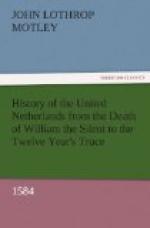A vast responsibility rested upon the head of a monarch, placed as Philip II. found himself, at this great dividing point in modern history. To judge him, or any man in such a position, simply from his own point of view, is weak and illogical. History judges the man according to its point of view. It condemns or applauds the point of view itself. The point of view of a malefactor is not to excuse robbery and murder. Nor is the spirit of the age to be pleaded in defence of the evil-doer at a time when mortals were divided into almost equal troops. The age of Philip II. was also the age of William of Orange and his four brethren, of Sainte Aldegonde, of Olden-Barneveldt, of Duplessis-Mornay, La Noue, Coligny, of Luther, Melancthon, and Calvin, Walsingham, Sidney, Raleigh, Queen Elizabeth, of Michael Montaigne, and William Shakspeare. It was not an age of blindness, but of glorious light. If the man whom the Maker of the Universe had permitted to be born to such boundless functions, chose to put out his own eyes that he might grope along his great pathway of duty in perpetual darkness, by his deeds he must be judged. The King perhaps firmly believed that the heretics of the Netherlands, of France, or of England, could escape eternal perdition only by being extirpated from the earth by fire and sword, and therefore; perhaps, felt it his duty to devote his life to their extermination. But he believed, still more firmly, that his own political authority, throughout his dominions, and his road to almost universal empire, lay over the bodies of those heretics. Three centuries have nearly past since this memorable epoch; and the world knows the fate of the states which accepted the dogma which it was Philip’s life-work to enforce, and of those who protested against the system. The Spanish and Italian Peninsulas have had a different history from that which records the career of France, Prussia, the Dutch Commonwealth, the British Empire, the Transatlantic Republic.




